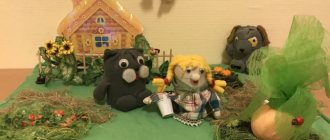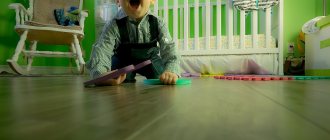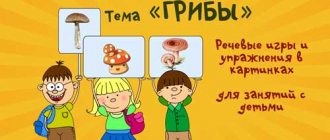Samoilova I.M., teacher-speech therapist of preschool educational institution No. 33 “Thumbelina”, Kamensk-Uralsky, Sverdlovsk region. In recent years, one of the priority areas of speech therapy work has been providing assistance to young children. In our preschool educational institution, a model of correctional speech work with young children has been created, which allows: - to identify children with speech development delays as early as possible; — reduce the gap between the moment the primary disorder is identified and the beginning of speech therapy; — purposefully involve parents in the process of children’s speech development. This model consists of two blocks. 1 block. General and individual correctional and developmental speech therapy influence Work with children from 1 year to 3 years old goes in two main directions: diagnostic and correctional and developmental. Diagnostics Diagnostics is of paramount importance for determining the state of speech and timely identification of children in need of corrective action. Diagnostic measures in the early age group (2nd year of life) 1. Observation. Conducted by a speech therapist during routine moments, games, classes conducted by the teacher. During observation, the following are assessed: - the child’s speech activity; - communication skills (what predominates - “adult” words, stencil words, onomatopoeia; gestural and facial means - gestures and their orientation, communicative or aggressive, whether they are accompanied by exclamations or “mute”); - elementary children's vocabulary. Considering the large number of children in nursery groups and the short duration of their working hours, the low level of contact of young children with unfamiliar people, the functional characteristics of early childhood (unstable attention, reduced performance, disinhibition), a speech therapist cannot find out the child’s vocabulary, but parents can do this. 2. Questionnaire for parents1. The questionnaire contains a list of typical words from the children's vocabulary. Parents fill it out twice a year (October and March). This allows us not only to trace the dynamics of the development of passive and active vocabulary, but also to clearly show parents what they need to strive for when raising children. 3. In-depth speech therapy examination of children with suspected delays in speech development (SDD) or manifestations of systemic speech disorder (SSD). Diagnostic measures in the first junior group (3rd year of life) 1. Observation by a speech therapist of the speech development of children during play, during routine moments, and in joint activities with an adult. During observation the following is noted: - understanding of spoken speech; - communication skills; — state of the dictionary; - skills of coherent statements; - features of the pronunciation aspect of speech. 2. In-depth speech therapy examination of all children before transferring them to the kindergarten group. The diagnostic system for children aged 2 and 3 years must meet the following requirements: - conciseness and accessibility of tasks (can be used both for express examination and more in-depth study); — the presence of standard indicators for identifying deviations and determining the degree of their severity; — taking into account the individual characteristics of the child’s development. All dynamic observations of the development of children's speech are recorded in an observation diary. It is started for each newly admitted child (early age group). Filling out begins with information from parents about early development, about the characteristics of the child’s speech and communication. Records of observation results are made at least twice a month, and if necessary, more often. Each record contains the following information: — observation time; — purpose of observation; — conditions for conducting observation; — result (what facts were revealed). Long absences of a child from kindergarten are also recorded in the diary. At the end of the first half of the year and at the end of the year, based on observations and in accordance with standard indicators, conclusions are drawn about the state of the baby’s speech development. In the second year of the child’s stay in the nursery (first junior group), if the state of affairs is favorable, diary entries can be limited to only stating the state of speech development at the beginning of the year, the first half of the year and the end of the year. The following are noted: — the state of the dictionary; - coherence and clarity of expression; — features of the pronunciation aspect of speech (the presence of defectively formed sounds, the state of syllable-by-syllable rearrangements). The diaries of children with developmental disabilities record: - a plan for individual work on speech development (drawn up for three months to clarify and adjust the general plan); — interaction with specialists (psychologist, music director, educators) on the formation of the psychological basis of speech; — dynamic observations of speech development; — consultations for parents. All the above requirements are met by a program for early comprehensive diagnosis of the level of development of a child from birth to 3 years1. The program is presented in the form of original tables and is very easy to use. This diagnosis is used not only by a speech therapist, but also by kindergarten teachers, which ensures a unified interpretation of the child’s examination results (Table 1). As a result of diagnostic measures, a clear picture of the speech development of each child is created. Thanks to this, at the exit from the nursery group of the kindergarten, children are differentiated as follows: - sent to the State Medical Practical Training Center for placement in special (correctional) groups; — those enrolled for further work at the logo station; - having phonetic deficiencies that can be corrected with the help of educators and parents (with one-time consultations with a speech therapist). Correctional and developmental work When drawing up a plan for speech therapy work in early age groups, the following were taken into account: - stages and patterns of systemic development of children's speech1; — objectives of the general development program. When working with young children of a mass group, it is necessary to take into account a program that determines the scope of children’s speech skills and abilities, and the requirements for them. This makes it possible to establish continuity in the content of speech education in groups (early age - the first youngest - the second youngest, etc.) and ensure the prospects for the development of children’s speech, i.e. lay the foundation for subsequent stages; — the principle of an integrated approach. Both in planning and in each game lesson, different but interrelated tasks are solved, covering all aspects of speech development (phonetics, prosody, vocabulary, articulation development); - developing, stimulating activity for young children. Their main goal is not correction, but to encourage communication, stimulate speech development, and increase the child’s speech activity. Developmental work in an early age group The plan for correctional and developmental work is drawn up weekly and contains the following sections: - lexical topic and sample dictionary (nouns, verbs, adjectives, adverbs); - facial and articulation exercises; — exercises for the development of prosodic organization of speech; - development of general and fine motor skills. Two frontal classes are held in September and October, as the adaptation period is underway. Starting from November, one frontal lesson is replaced by two subgroup lessons (with children younger and older than 2 years). This division is due to the fact that a difference of 3-5 months at this age is of great importance for the further development of the child. Developmental work in the first junior group In the first junior group, one frontal game lesson is carried out as an orientation lesson: certain vocabulary material on a lexical topic, models of phrases, sentences are given, articulation exercises and exercises are done to develop phonemic perception. The teacher practices lexical material during games and routine moments, and uses exercises from the orientation speech therapy session. The frontal lesson plan is drawn up monthly and contains sections: - lexical topic (one per month); - grammatical structure of speech; — formation of phonemic perception; — development of articulatory praxis; - development of prosody; - development of general and fine motor skills. Thus, the priority areas of work for a speech therapist in early age groups (in a speech center) can be called: stimulation of speech development and timely identification of children with speech problems. However, based on the results of observations throughout the year, children in these groups are identified who need special correctional classes. They are enrolled in a speech center in the next academic year. Also, individual lessons have to be carried out with children over 2 years old, from among those newly admitted to preschool educational institutions, since their speech development lags significantly behind the speech of children already studying. Due to the limited time of the speech therapist, two or three subgroups of two children with similar problems are formed. Classes are held twice a week with each subgroup (10-15 minutes). Parents of such children receive weekly recommendations from a speech therapist. Interaction of the speech therapist with teachers of nursery groups The speech therapist provides a plan of his work to the teachers (second copy). Their interaction ensures: - joint, more in-depth, systematic work on the formation and development of the dictionary; - the teacher partially uses the plans of the speech therapist in preparation for his classes, games that help consolidate speech skills (phonetics, prosody, articulation); — replacement of the weekly recording of the speech therapist’s recommendations to the teacher (the previously existing notebook “Recommendations of the Speech Therapist”). Weekly recordings of speech therapy recommendations were also abandoned for the following reasons: - the teacher is always present at the speech therapist’s frontal classes, noting children who need to be worked with individually; — the teacher has in his arsenal a large number of works of folklore, small genres and can independently select material for finger gymnastics and speech accompaniment of routine moments. It may be worthwhile for novice educators to provide detailed written recommendations. For the closest interaction in the work on the development of young children and the creation of a unified educational space, planning of lexical topics is also proposed to the educational psychologist and music director. 2 block. Interaction with parents Parents have long been recognized as the main educators, but they also have high hopes for kindergarten. It is very important to make parents active participants in the pedagogical process, to teach them to adequately evaluate and develop their child. To achieve this, certain forms of interaction with parents are used. 1. Parent meetings. Organizational - held in June, July (for parents of future preschool students). Participants include: preschool administration, medical worker, speech therapist, psychologist. Information and thematic meetings are held in September, January, the final one - in May (parents are introduced to regulatory documents, programs, program requirements, the organization of the activities of specialists in the group, and the results of the work). 2. Information corner “Speech development of the baby.” Contains materials for practical use in games and activities with children at home. Information changes two to three times a month. 3. Individual consultations with a speech therapist. At the first stage, they are initiated by teachers. Increasing the level of pedagogical knowledge helps parents understand and formulate issues related to child development. One day (permanent) per month is allocated. The speech therapist works in the evening hours. 4. Lecture hall “School of a young family”. Initially, at these meetings, practical advice was given on how to influence the child’s speech development. However, experience has shown that parents also need to explain the mechanism of action of these exercises. The theoretical aspect always arouses interest among parents, and methodological recipes are carried out consciously and with better quality. The lecture is held on the last Thursday of every month. 5. Demonstration of classes (recorded). It provides an opportunity to introduce parents to certain areas and techniques of working with children, demonstrate the successes of children, and arouse parents’ interest in the activities of teachers. 6. “Box of “hot” questions and suggestions.” Parents have the opportunity to anonymously (not only to the speech therapist, but also to the head of the preschool educational institution, doctor, teachers, psychologist). They receive an answer through the information corner, at a parent-teacher meeting. 7. Questionnaire. Allows you to clarify the degree of interest of parents in the development of their child, determine their needs, and determine the degree of satisfaction with the educational process.
Rating
( 1 rating, average 4 out of 5 )
Did you like the article? Share with friends:
You may also be interested







